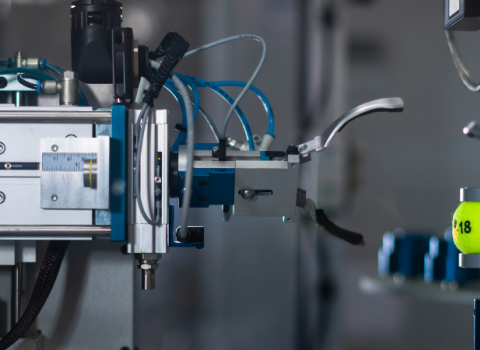The Commission believes a new plan for funding large research labs will help align EU and national priorities

Photo credits: Jan Kopřiva / Unsplash
The European Commission says Horizon Europe should cover “up to 20%” of the cost of constructing critical new European research infrastructures and upgrading existing facilities. But, despite the positive outlook of new funding, infrastructure operators and other observers note that challenges remain, as many research labs are still struggling to keep up with the full cost of running complex facilities and attract qualified human resources.
Europe’s research infrastructures come in all shapes and sizes, from large, single-site facilities such as the European Synchrotron Radiation Facility in Grenoble, to distributed or virtual facilities such as the European Social Survey.
In general, the primary responsibility for funding these infrastructures falls on the host country. But faced with low national budgets, increased operational costs and the lack of adequate funding instruments, EU governments struggle to invest, per the European Strategy Forum on Research Infrastructures.
Now, the Commission proposal for the next Horizon Europe programme includes a plan to ensure that 20% of the cost of new research infrastructures is covered by EU funds. A Commission official told Science|Business that the plan will also apply to projects aiming to upgrade and expand existing research facilities.
The Commission believes the co-financing mechanism will improve the alignment between EU and national priorities, and speed up the decision-making processes which, in turn, will attract and stabilise funding.
“It should bring further collective confidence in reaching agreed objectives in time to remain competitive, and therefore leverage further and faster engagement from more countries,” the Commission official said.
Funding for research infrastructures has been precarious and was a major point of contention in every iteration of the EU’s Framework Programme for research.
But, according to Nicolas Pade, executive director of the European Marine Biological Resource Centre (EMBRC), a co-investment from the Commission of 20% “could be highly attractive to the member states and encourage them to renew and/or invest in new technologies and facilities.”
While his centre is relatively well-funded in terms of national contributions, these cover its operational costs and “nothing else,” he added.
In his view, the Commission’s proposed scheme is even more appealing than the loans from the European Investment Bank, for instance. “Distributed [infrastructures] with smaller budgets are not likely to actually get themselves indebted with loans for their construction, so this mechanism is far more attractive,” he explained.
Pade however fears that the additional EU co-financing will not resolve other difficulties such as attracting human resources in research infrastructures.
At EMBRC, “it is a small number of dedicated and highly trained technicians that make the equipment and facilities work. These 20% won’t solve the problem of insufficient human resources to operate them,” he said.
Funding stability
The challenge research infrastructures face in covering costs was also made in a position paper published in June by the Cesaer university association. Most rely on competitive grants from public agencies, which makes it hard to recover the full cost of maintaining or upgrading their infrastructure. “It undercuts their ability to build reserves for reinvestment,” said Mattias Björnmalm, secretary general of Cesaer.
What is needed is a sustainable funding model that combines EU financing, national and regional public funding, and private investments.
“What really matters is legal clarity and alignment with state aid rules,” Björnmalm said. “Without that, infrastructures risk being locked into short-term fixes instead of long-term stability.” He would like to see the Commission channel national contributions into centrally managed EU instruments that are exempt from state aid rules, especially for cross-border infrastructures.
Related articles
- Horizon Europe budget to double, but €68B will remain in Competitiveness Fund
- Time and money key to greening Europe’s research infrastructures, says new ESFRI chair
Meanwhile, Rory Fitzgerald, director of the European Social Survey, wants to be sure that EU support is not limited to bricks and mortar. “We build new infrastructure every time we collect additional rounds of data,” said Fitzgerald. The Commission should also play a role in supporting these costs, he added.
Budget overhaul
Research infrastructure operators are also troubled by the increasing emphasis on competitiveness in the next iteration of Horizon Europe. “I am not particularly happy with research always being linked to a final spin-off or marketable product,” Pade said. Industry represents only a small proportion of the EMBRC’s users, so driving a disproportionate amount of funding in this direction might undermine its value as a research resource. “We work with companies on innovation whenever it is relevant and possible,” he said.
He welcomed the Commission decision to move research infrastructures funding to the newly created Pillar 4 in the next Horizon Europe, which will support a common European research policy. However, it is still unclear how much of the €16.2 billion proposed for Pillar 4 will go to infrastructures.
Finally, he wants to see a better integration of research infrastructures into the Commission’s strategic thinking. “Frequent shifting priorities makes it very challenging for the research infrastructures to meet expectations, and we are at a time where we should be consolidating their activities, not reinventing them,” he said.
Editor’s note: This story was updated 5 September 2025. A previous version included opinions on the proposed co-financing scheme that may have mischaracterised its potential impact on research infrastructures. We believe the updated version more accurately reflects concerns of research infrastructure operators.





 A unique international forum for public research organisations and companies to connect their external engagement with strategic interests around their R&D system.
A unique international forum for public research organisations and companies to connect their external engagement with strategic interests around their R&D system.